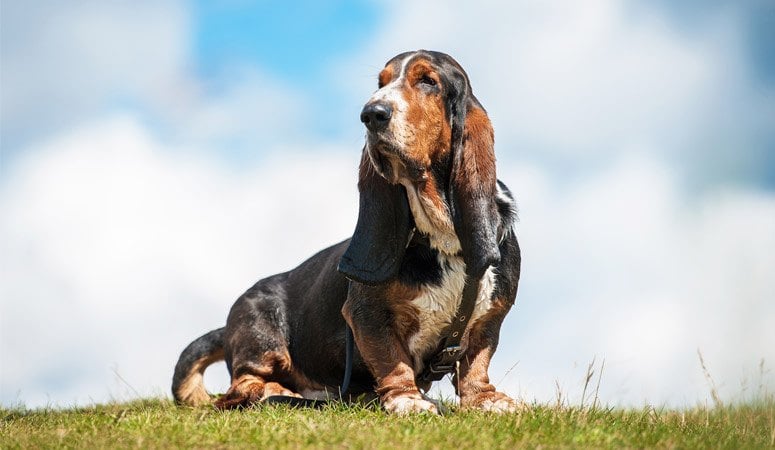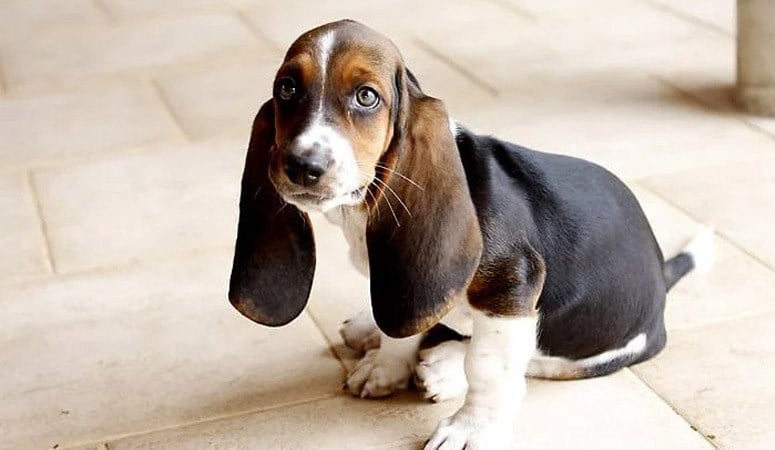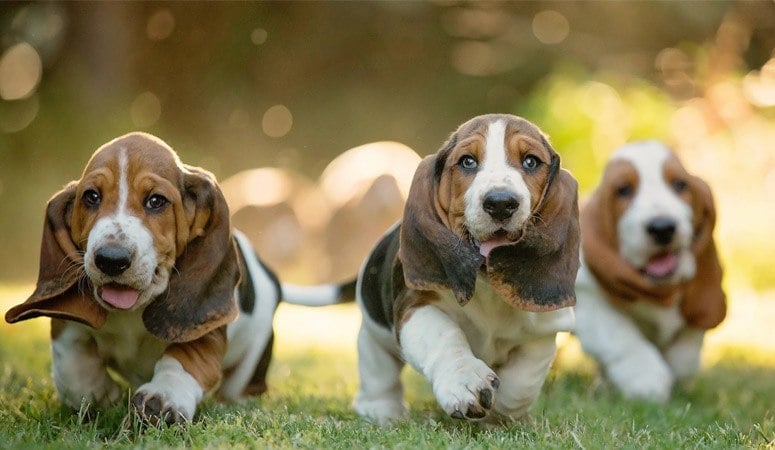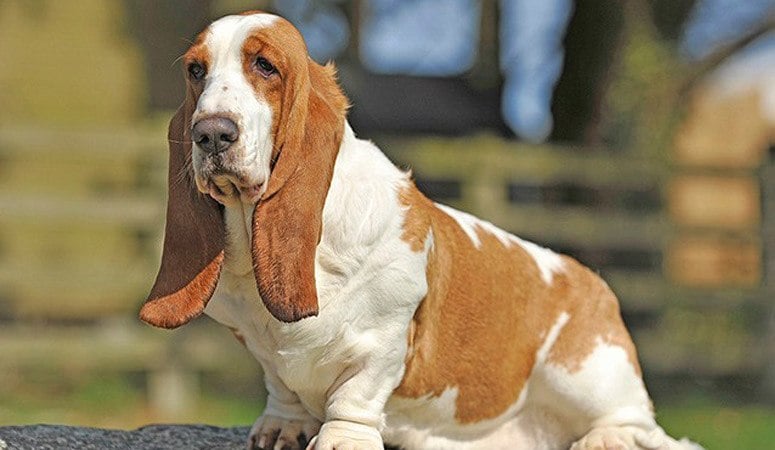Basset Hound
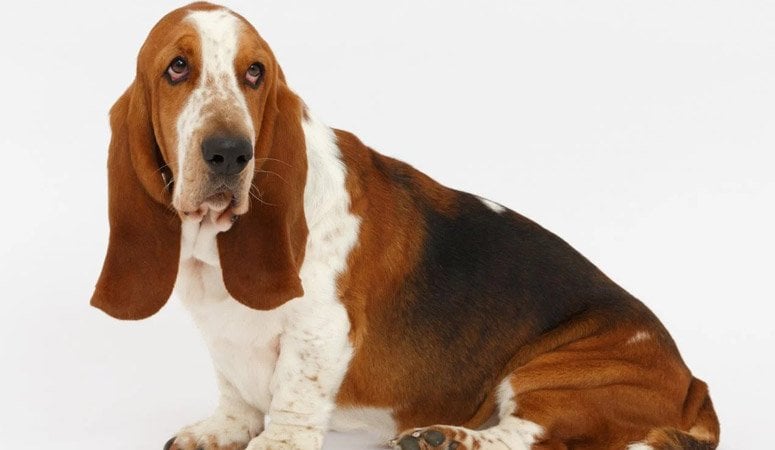
Recognizable with the floppy ears, low-slung silhouette, and hangdog expression, the sweet Basset Hound was bred for hunting small game such as rabbits. His long, heavy body and short legs make them easy to chase on foot and give them an edge in dense cover. They are easy-going and patient which are good family companions and friendly to kids.
| Other Names | Basset |
| Color | Black and Tan, Brown, Gray, Red, Tricolor, White |
| Height | Males: 14-17 inches. Females: 10-14 inches. |
| Weight | Males: 40-70 pounds. Females: 33-50 pounds. |
| Life Span | 12-13 years |
| Personality | Charming, Patient, Low-Key |
| Exercise | Couch Potato |
| Origin |
| Popularity | #37 |
| Groom Needs | 2-3 Times a Week |
| Kids Friendly | Yes |
| Dog Friendly | Yes |
| Watch Dog | |
| Family Dog | |
| Litter Size | 6-8 |
Basset Hound Pictures
Basset Hound Video
Introduction
Basset originates from France, and the French word Bas means “low”. Even though they are low on the ground, they are actually heavy, muscular dogs. They weigh from around 50-65 pounds and measure around 14 inches at the shoulder. They have short hard-textured smooth coats which is quite easy to take care of, coming in the classic tri-colors of black, white, and tan. They have other colors too. But apparently, the blue or gray is not popular as it means the Basset has genetic problems. He has a lot of loose skin on his face which is quite wrinkled over his brow. A lot of people think it makes the basset have a sad look for which he is quite famous and loved! His long ears often drag on the ground, picking up scents, which means they need to be checked and cleaned each week so as to prevent ear infections. Have you looked at his huge paws? His front feet turn outward slightly so that they balance with the width of the shoulders. He has a friendly disposition, but might become destructive and start howling if left alone for long. They are hearty eaters so their owners have to watch that they don’t become obese – this will give them back and leg problems, so regular exercise is essential.
Living with Basset Hound
Basset Hounds are easy to groom except for cleaning their ears and facial wrinkles and wiping up the drool they leave behind. Regular grooming sessions are an important part of keeping the breed healthy and happy. As Basset’s short hair can shed profusely, a regular brushing at least once a week with a soft brush or a shedding tool can keep their shedding under control. Also, it can remove the hair that is ready to shed and grooming is like an all-body massage that benefits his skin and overall health.
Basset Hound ears are long and drag the ground, so they can get very dirty. Because the air doesn’t circulate well in the inner ear, so ear infection is a health issue for a Basset Hound. Check the dog’s ears to make sure they don’t smell and there is no redness, and wash his ears with a mild cleanser once a week.
Give your Basset a bath every week or two to keep him smelling his best. Brush the dog’s teeth at least two or three times a week to remove tartar buildup and the bacteria that lurk inside it. And the daily brush is better to keep fresh breath and prevent gum disease.
Besides, nails should be trimmed once per month if the dog does not wear down the toenails naturally.
Regular and moderate exercise is enough for a Basset Hound’s daily exercise, usually composed of Short (15-20 minute) to medium (up to 30) walks, long walks occasionally, and chasing games. Exercise will help to keep the Basset healthy and prevent him from becoming overweight.
When walking, the dog should be on the leash because the basset hound tends to get caught up in following scent trails, and it’s not overly obedient when it comes to returning.
Also, Basset Hounds can be taken out to meet new people, other dogs and new situations which would help them grow into well-rounded, confident adult dogs.
Basset Hounds like to eat and are prone to obesity, you can measure your dog’s food and feed him twice a day rather than leaving food out all the time to keep him in a good shape and health. Usually, the food can be one and a half to two and half of high-quality dog food for a Basset Hound per day, and divided into three meals to prevent bloat. The exact food amount will vary depending on the size, weight, and age of your dog.
Both puppies and adult Bassett hounds need to be fed a high-quality, balanced diet throughout their lives to ensure that they are suitable for different stages of their lives.
Basset Hounds may be prone to the following conditions: elbow dysplasia, hip dysplasia, bleeding disorders, luxating patella, glaucoma, hypothyroidism, a dislocated kneecap once called a “trick knee” in humans
Major concerns: elbow dysplasia, OCD, thrombopathy, ectropion, entropion, gastric torsion, otitis externa, CHD, glaucoma
Minor concerns: vWD, patellar luxation
Suggested tests:
Thrombopathia Genetic Test
Ophthalmologist Evaluation
Total Annual Cost: $2745
Cost is estimated for the first year and may vary depending on many factors, such as dog food, health care, leash, collar, licensing, possible fencing, crates, training and obedience classes, dog-walking, grooming, treats, toys, flea, tick, and heart-worm meds, microchips, etc.
In the past few centuries, scent hounds were developed to hunt on their own and walk along tracks without distraction. So it could be a challenge when training a Basset Hound because they are very independent and tend to be stubborn and resist training, also they can seem aloof and not interested in following your commands. But, consistent and patient training can help your Basset Hound be a well-mannered, housetrained dog.
The puppies should be socialized appropriately to develop the amiable, outgoing personality which is characteristic of the breed, and it is important to use treats and early socialization in puppyhood. Besides, they can excel in performance and companion events such as earthdog, barn hunt, obedience, and agility.
History
It is thought that the Basset descended from the St. Hubert Hound – the ancestor of the present-day Bloodhound. Apparently a mutation in the St. Hubert strain created the dwarfed hound or short-legged dog. However, the first record mentioned of a basset was in a book about hunting, called La Venerie, written by Jacques du Fouilloux in 1585. The illustrations show that the early French Basset Hounds resembled the present-day Basset Artésien Normand, a dog breed today known in France.
The dogs were very popular with the French aristocracy. After the French Revolution though, they became hunting dogs of the commoners who couldn’t afford horses so they followed the dogs on foot.
Bassets made their way to Britain by the mid-19th century. Lord Galway imported a pair to England in 1866 that produced a litter of 5 pups.
In 1874, Sir Everett Millais imported a Basset Hound from France. It was called Model where it was promoted in England and joined a breeding program. Millais is considered to be the “father of the breed” in England.
In 1882, the Kennel Club in England was formed and the breed was accepted in 1884.
It is though the Basset came to America in colonial times and the American Kennel Club (AKC) registered the dog in 1885. Number 28 at the AKC has surely crept into the hearts of the Americans!
Helpful Information
Breed Club: BASSET HOUND CLUB OF AMERICA, INC.
Breed Club Link: http://basset-bhca.org/
Breed Club Rescue: BHCA RECOGNIZED RESCUE GROUPS
Breed Club Rescue Link: https://basset-bhca.org/find-a-basset/basset-rescue/bhca-recognized-rescue/

